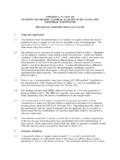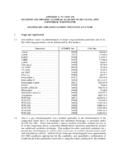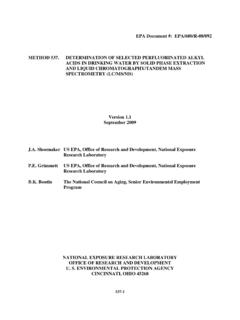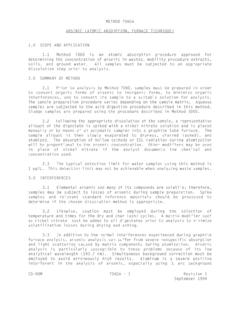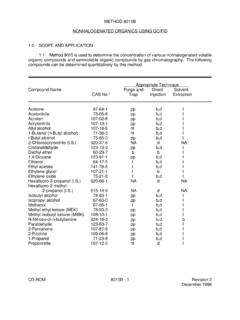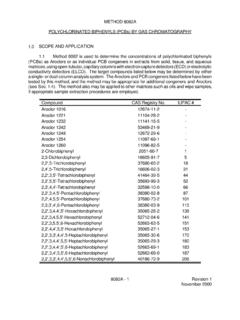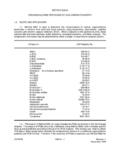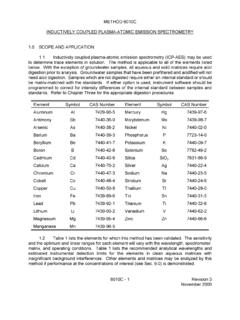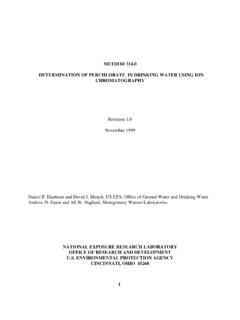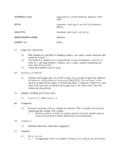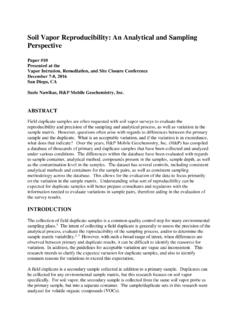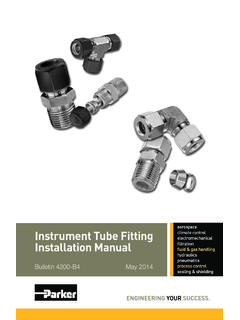Transcription of METHOD 9056 DETERMINATION OF INORGANIC …
1 CD-ROM9056 - 1 Revision 0 September 1994 METHOD 9056 DETERMINATION OF INORGANIC anions BY ION AND METHOD addresses the sequential DETERMINATION of the anionschloride, fluoride, bromide, nitrate, nitrite, phosphate, and sulfate in thecollection solutions from the bomb combustion of solid waste samples, as well asall water METHOD detection limit (MDL), the minimum concentration of asubstance that can be measured and reported with 99% confidence that the valueis above zero, varies for anions as a function of sample size and theconductivity scale used. Generally, minimum detectable concentrations are in therange of mg/L for F and mg/L for Br, Cl, N0, N0, PO, and SO with-----3-2-3244a 100- L sample loop and a 10- mho full-scale setting on the conductivitydetector.
2 Similar values may be achieved by using a higher scale setting and anelectronic integrator. Idealized detection limits of an order of magnitude lowerhave been determined in reagent water by using a 1- mho/cm full-scale setting(Table 1). The upper limit of the METHOD is dependent on total anionconcentration and may be determined experimentally. These limits may be extendedby appropriate OF small volume of combustate collection solution or other watersample, typically 2 to 3 mL, is injected into an ion chromatograph to flush andfill a constant volume sample loop.
3 The sample is then injected into a streamof carbonate-bicarbonate eluent of the same strength as the collection solutionor water sample is pumped through three different ion exchange columns andinto a conductivity detector. The first two columns, a precolumn or guard columnand a separator column, are packed with low-capacity, strongly basic anionexchanger. Ions are separated into discrete bands based on their affinity forthe exchange sites of the resin. The last column is a suppressor column thatreduces the background conductivity of the eluent to a low or negligible leveland converts the anions in the sample to their corresponding acids.
4 Theseparated anions in their acid form are measured using an electrical-conductivitycell. anions are identified based on their retention times compared to knownstandards. Quantitation is accomplished by measuring the peak height or area andcomparing it to a calibration curve generated from known species with a retention time similar to that of the desired ionwill interfere. Large quantities of ions eluting close to the ion of interestwill also result in an interference. Separation can be improved by adjusting theeluent concentration and/or flow rate. Sample dilution and/or the use of the CD-ROM9056 - 2 Revision 0 September 1994method of standard additions can also be used.
5 For example, high levels oforganic acids may be present in industrial wastes, which may interfere withinorganic anion analysis. Two common species, formate and acetate, elute betweenfluoride and chloride. bromide and nitrate elute very close together, they arepotential interferences for each other. It is advisable not to have Br/N0--3ratios higher than 1:10 or 10:1 if both anions are to be quantified. If nitrateis observed to be an interference with bromide, use of an alternate detector( , electrochemical detector) is interferences may be caused by contaminants in the reagentwater, reagents, glassware, and other sample processing apparatus that lead todiscrete artifacts or elevated baseline in ion that contain particles larger than m and reagentsolutions that contain particles larger than m require filtration toprevent damage to instrument columns and flow a packed bed suppressor column is used, it will be slowly consumedduring analysis and, therefore, will need to be regenerated.
6 Use of either ananion fiber suppressor or an anion micromembrane suppressor eliminates the time-consuming regeneration step through the use of a continuous flow of AND chromatograph, capable of delivering 2 to 5 mL of eluent perminute at a pressure of 200 to 700 psi ( to MPa). The chromatograph shallbe equipped with an injection valve, a 100- L sample loop, and set up with thefollowing components, as schematically illustrated in Figure , a guard column placed before the separator columnto protect the separator column from being fouled by particulates orcertain organic constituents (4 x 50 mm, Dionex P/N 030825 [normal run],or P/N 030830 [fast run], or equivalent).
7 Column, a column packed with low-capacitypellicular anion exchange resin that is styrene divinylbenzene-based hasbeen found to be suitable for resolving F, Cl, N0, P0, Br, N0, and----3--243S0 (see Figure 2) (4 x 250 mm, Dionex P/N 03827 [normal run], or P/N4-2030831 [fast run], or equivalent). column, a column that is capable of convertingthe eluent and separated anions to their respective acid forms (fiber,Dionex P/N 35350, micromembrane, Dionex P/N 38019 or equivalent). , a low-volume, flowthrough, temperature-compensated, electrical conductivity cell (approximately 6 L volume,Dionex, or equivalent) equipped with a meter capable of reading from 0 to1,000 seconds/cm on a linear , capable of delivering a constant flow of approximately2 to 5 mL/min throughout the test and tolerating a pressure of 200 to 700 psi ( to MPa).
8 CD-ROM9056 - 3 Revision 0 September , compatible with the detector output with a full-scaleresponse time in 2 seconds or , minimum capacity of 2 mL and equipped with a male and regenerant reservoirs, suitable containers for storingeluents and regenerant. For example, 4 L collapsible bags can be , to integrate the area under the chromatogram. Differentintegrators can perform this task when compatible with the electronics of thedetector meter or recorder. If an integrator is used, the maximum areameasurement must be within the linear range of the balance, capable of weighing to the nearest , Class A volumetric flasks, beakers: assorted grade chemicals shall be used in all tests.
9 Unless otherwiseindicated, it is intended that all reagents shall conform to the specificationsof the Committee on Analytical Reagents of the American Chemical Society, wheresuch specifications are available. Other grades may be used, provided it isfirst ascertained that the reagent is of sufficiently high purity to permit itsuse without lessening the accuracy of the water. All references to water in this METHOD refer toreagent water, as defined in Chapter One. Column life may be extended by passingreagent water through a m filter prior to , NaHC0 NaC0. Dissolve g of sodium323bicarbonate ( NaHC0) and g of sodium carbonate ( NaC0) in323reagent water and dilute to 4 L with reagent regenerant solution.
10 Add 100 mL of 1N HS0 to 3 L of24reagent water in a collapsible bag and dilute to 4 L with reagent solutions (1,000 mg/L). stock solution ( mL = mg Br). Dry-approximately 2 g of sodium bromide (NaBr) for 6 hours at 150EC, and coolin a desiccator. Dissolve g of the dried salt in reagent water,and dilute to 1 L with reagent stock solution ( mL = mg Cl). Dry sodium-chloride (NaCl) for 1 hour at 600EC, and cool in a desiccator. g of the dry salt in reagent water, and dilute to 1 L with stock solution ( mL = mg F). g of sodium fluoride (NaF) in reagent water, and dilute to 1 L withreagent water.
